

40 maps that explain the internet. The internet increasingly pervades our lives, delivering information to us no matter where we are.
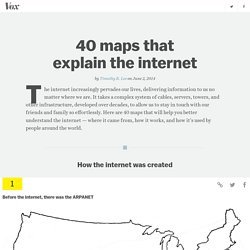
It takes a complex system of cables, servers, towers, and other infrastructure, developed over decades, to allow us to stay in touch with our friends and family so effortlessly. Here are 40 maps that will help you better understand the internet — where it came from, how it works, and how it's used by people around the world. The WELL.
The Whole Earth 'Lectronic Link, normally shortened to The WELL, is one of the oldest virtual communities in continuous operation.
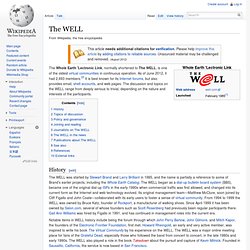
As of June 2012, it had 2,693 members.[2] It is best known for its Internet forums, but also provides email, shell accounts, and web pages. The discussion and topics on the WELL range from deeply serious to trivial, depending on the nature and interests of the participants. History[edit] In August 2005 Salon Media Group announced that it was looking for a buyer for the WELL, in order to concentrate on other business lines. In November 2006, a press release of The WELL said, "As Salon has not found a suitable purchaser, it has determined that it is currently in the best interest of the company to retain this business and has therefore suspended all efforts to sell The WELL In June 2012 Salon once again announced that it was looking for a buyer for the WELL as its subscriber base "did not bear financial promise". Topics of discussion[edit] See also[edit] ARPANET. Da Wikipedia, l'enciclopedia libera.
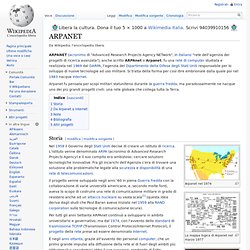
ARPANET (acronimo di "Advanced Research Projects Agency NETwork", in italiano "rete dell'agenzia dei progetti di ricerca avanzata"), anche scritto ARPAnet o Arpanet, fu una rete di computer studiata e realizzata nel 1969 dal DARPA, l'agenzia del Dipartimento della Difesa degli Stati Uniti responsabile per lo sviluppo di nuove tecnologie ad uso militare. Si tratta della forma per così dire embrionale dalla quale poi nel 1983 nacque Internet.
Arpanet fu pensata per scopi militari statunitensi durante la guerra fredda, ma paradossalmente ne nacque uno dei più grandi progetti civili: una rete globale che collega tutta la Terra. Storia[modifica | modifica sorgente] Arpanet nel 1974 La mappa logica di Arpanet nel marzo 1977 Il primo router di Arpanet, il BBN Interface Message Processor (IMP), del 1969 Nel 1958 il Governo degli Stati Uniti decise di creare un istituto di ricerca.
Italiaonline. Italiaonline. Servizi web - Registrazione domini, hosting fino a 10 GB, housing e colocation. From semantic Web (3.0) to the WebOS (4.0) Nova Spivack of Radar Networks maps out his view of the evolution of the Web over the next 25 years.

Nova said he isn't sure about exact dates or technologies on the top end of the map, but his view of ten-year blocks to fully evolve each phase is realistic. Nor should we get hung up on the naming convention--1.0, 2.0, etc. The idea that the next major deepening of the Internet as a platform will involve the semantic Web is reasonable, and was the subject of much discussion in November. Nova's stealth-mode company is working on what he describes as a "Java-based framework for semantic web applications and services that has some similarities to Ruby on Rails, and also includes a lot of other technology such as our extremely fast and scaleable storage layer for semantic data tuples, powerful semantic query capabilities, and a range of algorithms for analyzing data and doing intelligent things for users.
" Source: Nova Spivack and Radar Networks. The History of the Internet in a Nutshell. By Cameron Chapman If you’re reading this article, it’s likely that you spend a fair amount of time online.
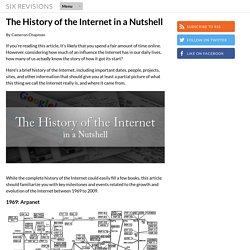
However, considering how much of an influence the Internet has in our daily lives, how many of us actually know the story of how it got its start? Here’s a brief history of the Internet, including important dates, people, projects, sites, and other information that should give you at least a partial picture of what this thing we call the Internet really is, and where it came from. While the complete history of the Internet could easily fill a few books, this article should familiarize you with key milestones and events related to the growth and evolution of the Internet between 1969 to 2009. 1969: Arpanet Arpanet was the first real network to run on packet switching technology (new at the time). Usenet. A diagram of Usenet servers and clients.
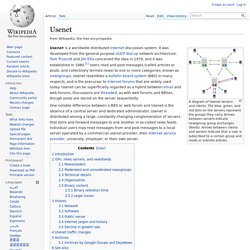
The blue, green, and red dots on the servers represent the groups they carry. Arrows between servers indicate newsgroup group exchanges (feeds). Arrows between clients and servers indicate that a user is subscribed to a certain group and reads or submits articles. One notable difference between a BBS or web forum and Usenet is the absence of a central server and dedicated administrator. Usenet is distributed among a large, constantly changing conglomeration of servers that store and forward messages to one another in so-called news feeds. Hyperlink.
Internet, attualità. The p1r47world guide.